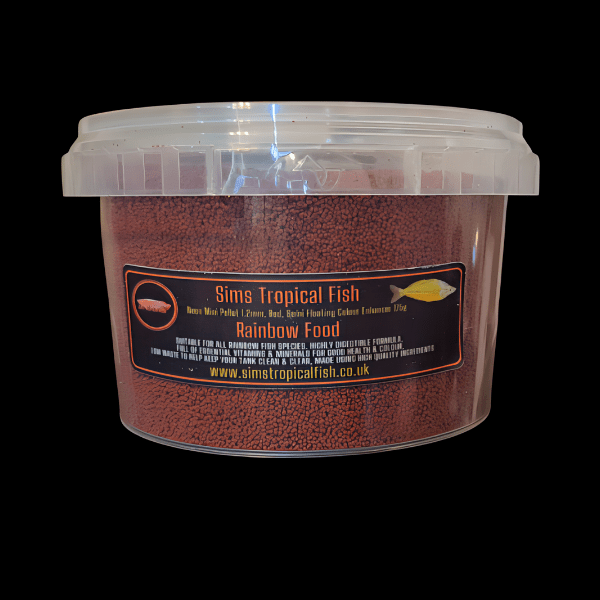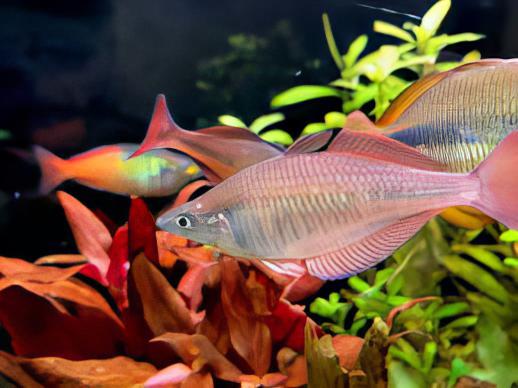Description
Santani Rainbow Fish Chilatherina Sentaniensis
Species Summary
Chilatherina sentaniensis was originally described as Rhombatractus sentaniensis by Weber in 1907 and assigned to the genus Chilatherina by Regan in 1914. Perhaps the most distinguishing feature of the Chilatherina genus is their deep, laterally compressed body that increases with age, particularly in males, and Chilatherina sentaniensis is no different. Their overall body colouration is silvery-blue or greenish on the upper back fading laterally to orange or red. They have a diffuse blue or green mid-lateral band and narrow silver or light blue stripes between each horizontal scale rows. Males often show 6-8 reddish-brown bars on the lower sides of the body between the pectoral fin base and the level of the middle anal rays. However, colour can be variable depending on captive conditions. Males are more brightly coloured, larger, and deeper bodied than females. Males may reach a maximum size of 12 cm, but females are usually less than 10 cm.
Distribution & Habitat
Chilatherina sentaniensis are endemic to Lake Sentani and its tributaries streams. Lake Sentani is located some 10 kilometres west of Jayapura at the NE extremity of West Papua. It is an irregularly shaped lake with approximate dimensions of 28 km (E-W) by 19 km (N-S) and a surface area of 104 km². Its blue-green waters are dotted with at least 16 small islands, and it is surrounded by hillsides in the south and the Cyclops Mountains in the north, which separate the lake from the Pacific Ocean. Lake Sentani is by far the largest of the West Papuan lakes and has a catchment area of about 600 km². About 35 small rivers flow into the lake, and there is one natural outlet in the south-eastern tip, via the Jafuri and Tami rivers to the Pacific Ocean near the Papua New Guinea border. The lake is divided into three main sections with recorded depths of 7 to 52 metres. According to surveys in 1970-71, 1984 and 1987 the lake is thermally unstratified, with surface temperatures of 29-32°C and pH 6.2-6.8.
Unfortunately, because of its proximity to the provincial capital Jayapura and the large population around it, Sentani is no longer the pristine lake it once was. Human activities surrounding the lake have led to noticeable deforestation around it, water pollution, and the introduction of exotic species. A survey by Samuel J. Renyaan in 1993 recorded 33 species of fish, of which 13 were introduced.
More recent surveys have shown an increase in introduced species but the impact on the total fish population has not been documented. A study on water pollution levels in Lake Sentani in 2000 found that the major sources of pollution were human settlements, livestock, and the traditional market. Other pollution sources included outboard motors, chemicals from washing, and some small-scale organic materials from the settlements surrounding the lake. These pollutants have decreased Lake Sentani water quality and resulted in the water not being suitable for drinking without proper treatment.
Chilatherina sentaniensis is listed as a threatened species according to the IUCN Red List because of habitat degradation and the introduction of exotic species into Lake Sentani. The species was reported to occur only in Lake Sentani and its tributaries. Chilatherina sentaniensis were found in one of the tributaries of Lake Sentani (Jembatan II Creek), around 12 km southwest of Jayapura until approximately the early-2000s, when the habitat became polluted as a result of small-scale gold mining in its headwaters. Then in 2006, they were found in another tributary (Mekaye Creek) around 14 km east of Jayapura. However, in more recent times, surveys have failed to find the species in these locations. It is likely that habitat degradation is the cause. It was therefore believed that Chilatherina sentaniensis may be extinct in Lake Sentani (Ohee 2013). Nevertheless, more recent surveys at 38 sampling sites around the shores of Lake Sentani, and the river systems in the vicinity of the Cyclops Mountains, found what is thought to be Chilatherina sentaniensis at 15 locations within Lake Sentani and its tributaries. In addition to finding Chilatherina sentaniensis, the survey also recorded new records for Melanotaenia affinis in the river systems in the vicinity of the Cyclops Mountains (Kadarusman et al., 2016).
Remarks
Chilatherina sentaniensis was originally collected from Lake Sentani and the Sekanto River during the 1899-1900 Siboga Expedition to the Dutch East Indies (West Papua). The Sekanto River is a tributary of the Tami River. They were also collected during the expedition of the British Ornithologists’ Union expedition to New Guinea in 1909-1911. A large collection of specimens were also obtained from Lake Sentani by Marinus Boeseman during a collecting expedition for the Leiden Museum in 1954-1955. The lectotype of Chilatherina sentaniensis, preserved in the Amsterdam museum, shows a very long snout, which according to Gerald Allen, is an important distinguishing mark. In his 1982 book, “Rainbowfishes of Australia and New Guinea” Allen showed Chilatherina sentaniensis among the colour sketches, because he didn’t have any photographs of live specimens.
In 1982, live specimens of Chilatherina fasciata were collected from the Jafuri River and during the 1980s and early 1990s they were being distributed in the hobby as Chilatherina sentaniensis. In his “Field Guide to the Freshwater Fishes of New Guinea” of 1991 Gerald Allen noted that probably all records of C.
sentaniensis in the aquarium literature were C. fasciata varieties and that the most recent collection of the true Chilatherina sentaniensis was made in 1954. In yet another book, “Rainbowfishes in Nature and in the Aquarium”, published in 1995, Gerald Allen shows a picture of a live specimen, with the remarkably long snout, that was collected in a small tributary stream flowing into the north-eastern end of Lake Sentani in 1991. Several specimens were netted along with Chilatherina fasciata and Glossolepis incisus. None of these specimens however, were collected live for the aquarium hobby. Nonetheless, live specimens were collected from the lake in 1991 by Charles Nishihira and distributed in the aquarium hobby.













